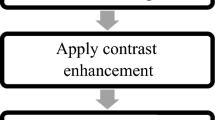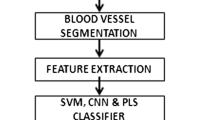Abstract
Purpose of the study
As per the estimation of the World Health Organization, around 400,000,000 people may be affected by diabetes in the year 2014. It is rapidly increasing double by the upcoming year 2030. Diabetic mellitus, also called diabetes, can cause critical issues of retinal disease such as diabetic retinopathy (DR) which causes blindness. Exudates are considered as the major sign of diabetic maculopathy (DM) which may lead to visual disturbances.
Methods
The main purpose is to develop a computer-aided technique for the detection of hard exudates to assist in the diagnosis of DR. It mainly focuses on the identification on the yellow lipids that include hard exudates. The diseased retinal image is given as an input to the classifier; it produces the output as exudates or non-exudates. In the proposed work, the classifier such as support vector machine and multilayer perceptron are used to find out the accurate prediction of exudates and non-exudates. First, the fundus images are allowed to preprocessing technique to get the filtered, contrast enhanced image. Second, the features such as blood vessel segmentation implements morphological operation for the detection of hard exudates by measuring the size of the lesion, and optic disc (OD) is measured and eliminated by comparing the parameters with the size of the lesions. Third, the segmented images are given as an input to the classifier such as SVM and MLP; it classifies and given as an output about the presence or absence of the exudates. In the proposed work, the experimental tests are carried out, and the results are verified on a different set of images.
Results
The average accuracy values obtained using SVM and MLP classifiers for 140 images from real-time databases collected from Aravind Eye Hospital, Coimbatore are 88% and 95% respectively.












Similar content being viewed by others
Data availability and material
NIL
Code availability
NIL.
Abbreviations
- DR:
-
Diabetic retinopathy
- DM:
-
Diabetic maculopathy
- OD:
-
Optic disc
- DME:
-
Diabetic macular edema
- HE:
-
Hard exudates
- OCT:
-
Optical coherence tomography
- NPDR :
-
Non-proliferative diabetic retinopathy
- PDR:
-
Proliferative diabetic retinopathy
- ME:
-
Macular edema
- MS:
-
Microaneurysms
- HR:
-
Hemorrhages
- Ex:
-
Exudates
- HE:
-
Hard exudates
- FOV:
-
Field of view
- RBF:
-
Radial basis function
- CLAHE:
-
Contrast limited adaptive histogram Equalization
- SVM:
-
Support vector machine
- MLP:
-
Multilayer perceptron
- FFNN:
-
Feed forward neural network
References
Singer DE, Natham DM, Fogel HA, Schachat AP. Screening for diabetic retinopathy. Ann Intern Med. 1992;116(8):660–71.
Akram MU, Tariq A, Khan SA, Javed MY. Automated detection of exudates and macula for grading of diabetic macular edema. Comput Methods Programs Biomed. 2014;114(2):141–52.
Zhang X, Thibault G, Decenciere E, Marcotegui B, Läy B, Danno R, Cazuguel G, Quellec G, Lamard M, Massin P, et al. Exudate detection in colorretinal images for mass screening of diabetic retinopathy. Med Image Anal. 2014;18(7):1026–43.
Jaya T, Dheeba J, Singh NA. Detection of hard exudates in colour fundus images using fuzzy support vector machine-based expert system. J Digit Imaging. 2015;28(6):761–8.
Nazir Tahira, Irtaza Aun, Shabbir Zain, Javed Ali, Akram Usman, Mahmood Muhammad Tariq. Diabetic retinopathy detection through novel tetragonal local octa patterns and extreme learning machines. Artif Intell Med. 2019;99:101695. https://doi.org/10.1016/j.artmed.2019.07.003.
Tang Li, Niemeijer Meindert, Reinhardt Joseph M, Garvin Mona K, Abramoff Michael D. Splat feature classification with application to retinal hemorrhage detection in fundus images. IEEE Trans Med Imaging. 2013;32(2):364–75. https://doi.org/10.1109/TMI.2012.2227119.
Gandhi, Mahendran, Dhanasekaran R. Diagnosis of diabetic retinopathy using morphological process and SVM classifier. In: International Conference on Communications and Signal Processing (ICCSP), p. 873–877. 2013.
Sangeethaa SN, Uma Maheswari P. An intelligent model for blood vessel segmentation in diagnosing DR using CNN. J Med Syst. 2018;42:175. https://doi.org/10.1007/s10916-018-1030-6.
Deepak KS, Sivaswamy J. Automatic assessment of macular edema from color retinal images. IEEE Tran Med Imaging. 2012;31(3):766–76.
Ranamuka NG, Meegama RGN. Detection of hard exudates from diabetic retinopathy images using fuzzy logic, image processing. IET. 2013;7(2):121–30.
Chowdhury AR, Banerjee S. Detection of cotton wool spots from retinal images using fuzzy C means. Int J Comput Appl (0975- 8887). 2015;113(11):14–7.
Garca M, Valverde C, Lpez MI, Poza J, Hornero R. Comparison of logistic regression and neural network classifiers in the detection of hard exudates in retinal images, 35th Annual International Conference on Engineering in Medicine and Biology Society (EMBC), pp. 5891–5894. 2013.
Zubair M, Yamin A, Khan S. Automated detection of optic disc for the analysis of retina using color fundus image, IEEE International Conference on Imaging Systems and Techniques. 2013;239–242
Irshad S, Akram M, Salman M, Yasin U. Automated detection of cotton wool spots for the diagnosis of hypertensive retinopathy, 7th Cairo International Biomedical Engineering Conference, December 11–13, 2014.
Wan S, Liang Y, Zhang Y. Deep convolutional neural networks for diabetic retinopathy detection by image classification. Comput Electr Eng. 2018;72:274–82.
Salamat Nadeem, SaadMissen Malik M, Rashid A. Diabetic retinopathy techniques in retinal images: a review”. Artif Intell Med. 2019;97:168–88.
Zhang Wei, Zhong Jie, Yang Shijun, Gao Zhentao, Junjie Hu, Chen Yuanyuan, Yi Zhang. Automated identification and grading system of diabetic retinopathy using deep neural networks”. Knowledge-Based Syst. 2019;175:12–25.
Galshetwar GM, Waghmare LM, Gonde AB, Murala S. Edgy salient local binary patterns in inter-plane relationship for image retrieval in diabetic retinopathy. Proc Comput Sci. 2017;115:440–7.
Farokhian F, Yang C, Demirel H, Shuicai Wu, Beheshti I. Automatic parameters selection of Gabor filters with the imperialism competitive algorithm with application to retinal vessel segmentation. Biocybern Biomed Eng. 2017;37(1):246–54.
Annunziata R, Garzelli A, Ballerini L, Mecocci A, Trucco E. Leveraging multiscale hessian-based enhancement with a novel exudate inpainting technique for retinal vessel segmentation. IEEE J Biomed Health Inform. 2016;20(4):1129–38.
Xu X, Lee K, Zhang L, Sonka M, Abramoff MD. Stratified sampling voxel classification for segmentation of intraretinal and subretinal fluid in longitudinal clinical OCT data. IEEE Trans Med Imaging. 2015;34(7):1616–23.
Peto T, Tadros C. Screening for diabetic retinopathy and diabetic macular edema in the United Kingdom. Curr Diab Rep. 2012;12(4):338–45.
Jia Y, Shelhamer E, Donahue J, Karayev S, Long J, Girshick R, Guadarrama S, Darrell T. Caffe: convolutional architecture for fast feature embedding. arXiv preprint arXiv:1408.5093, 2014.
Li H, Chutatape O. Automated feature extraction in color retinal images by a model-based approach. IEEE Trans Biomed Eng. 2004;51(2):246–54.
Osareh A, Mirmehdi M, Thomas B, et al. Comparison of colour spaces for optic disc localisation in retinal images. In: 16th International Conference on Pattern Recognition 2002:743–6.
Author information
Authors and Affiliations
Contributions
NIL.
Corresponding author
Ethics declarations
Competing interests
The authors declare no competing interests.
Additional information
Publisher's note
Springer Nature remains neutral with regard to jurisdictional claims in published maps and institutional affiliations.
Rights and permissions
About this article
Cite this article
Sangeethaa, S.N., Jothimani, S. Detection of exudates from clinical fundus images using machine learning algorithms in diabetic maculopathy. Int J Diabetes Dev Ctries 43, 25–35 (2023). https://doi.org/10.1007/s13410-021-01039-y
Received:
Accepted:
Published:
Issue Date:
DOI: https://doi.org/10.1007/s13410-021-01039-y




